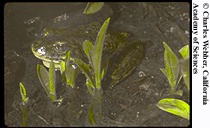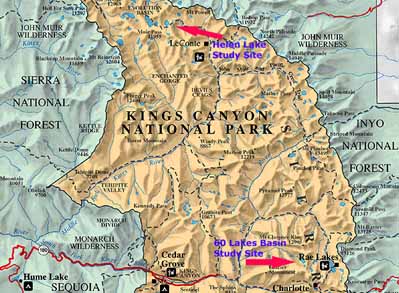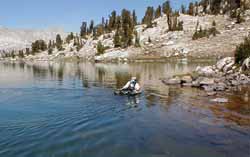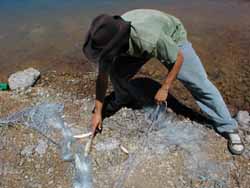A
Summer Spent Saving Frogs:
Applying Research to the Real World
by Ryan Peek
Biology Department, UC Davis
 |
| Mountain Yellow-legged frog, patiently waiting to reclaim an old swimming hole. |
Imagine going to work every morning at over 11,000 feet in the rugged and beautiful Sierra Nevada mountains. This last summer, the National Park Service acted on recent research to restore habitat for the endangered mountain yellow-legged frog (Rana muscosa). These frogs have declined dramatically throughout the Sierra in the last two decades. So far, one of the only proven causes is the introduction of trout in the yellow-legged's native habitat.
The park service project had been developed slowly over the last several years and finally received approval this summer. Beginning in 1998, funding to restore frog habitat was sought by Sequoia and Kings Canyon National Park biologist Harold Werner. When funds did become available, an environmental assessment (EA) of the proposed restoration project was written in early 2001. It was then publicized and open for comments from the public in the spring. Comments were mostly favorable and the project was approved. A three-person crew was hired in the spring of 2001 and I was lucky enough to be on that crew.
A Day in the
Life
It was exciting to be part of a restoration project in it's earliest stages.
We were pioneering new techniques to achieve our goals of bringing back the
yellow-legged frog. It was also a hugely rewarding experience since we were
in the unique position of actually living at the restoration sites. This meant
putting together enough food and supplies to live in the High Sierra for 3
to 5 weeks at a time. No other job, book, or class could have taught us as
much as living in the backcountry ultimately did. It was also startling to
realize how few material needs we actually required to survive when compared
to all the "necessities" we had once regarded as essential.
 |
| In the 2001 field season, the mountain yellow-legged frog restoration project was carried out at two sites: Helen Lake and Sixty Lake Basin in Kings Canyon National Park. |
We worked at two sites during the summer. Both are within Kings Canyon National Park and are between 10,000 and 11,000 feet. The first is located just southeast of Helen Lake, the second was in the Sixty Lakes basin immediately west of Rae Lakes. Our primary goal was to remove all reproductively mature fish from selected lakes and do so with minimal environmental impact. We also conducted population surveys of amphibians in the vicinity to monitor the progress of the frog populations in the coming years. All of these lakes were in the vicinity of existing populations of R. muscosa. Preliminary studies in 60 Lake Basin by Vance Vredenburg and others showed that merely removing fish from ponds and lakes would make it possible for the frogs to return and repopulate their former habitat.
The yellow-legged frog is unique because the tadpoles must spend several years maturing before they can metamorphose into adults. During the winter they are forced into deeper water due to the ice that forms in the shallows. Once the lake has frozen over, they become one of the few sources of food for the fish. The removal of any life stage will obviously impact the frog's existence. R muscosa has a yellow underbelly that can range from pale yellow to almost orange and usually any variety of mottled browns dorsally. The coloring acts as excellent camouflage but it's not enough to protect them from dense populations of fish.
The yellow-legged frogs we saw were quite curious. Frequently on surveys, they would jump or swim away from us initially but then they would come back and watch us unless they felt threatened. The largest frogs we saw were a little over three inches long and approximately two inches wide.
Fishin' &
Floatin'
Fish removal was about 70 percent of our job. We used gill nets and an electro-fisher
to accomplish this task. Gill nets are made of fine mesh fishing line, which
has a lead weighted line on the bottom and a float line on the top. The 30
nets we used were approximately 30 meters in length. Each site had about four
lakes and the deployment of nets occurred in every lake. The end of the net
has a float attached to it, which allowed us to locate it when we were pulling
the nets back in. All of the floats were numbered so that we could identify
nets when we recorded the data sets.
Hikers often asked what we were doing and we would always take the time to talk about our project. Some were concerned the Park Service would eliminate fishing from the Sierra. We explained that, if the method was successful and eventually approved for other areas, fish would be removed from only a handful of Sierra lakes, though in large enough areas to insure a safe breeding population free of fish predation. In all cases, the hikers were satisfied they'd still find plenty of places in the backcountry to fish.
Initially we would set about three or four nets per lake to determine the density of the fish. Based on that, we would then decide how many nets each lake would need to adequately remove all of the fish. The protocol that we followed was from Roland Knapp's 2001 Inventory Instructions, but we adjusted a few things to make procedures run more efficiently and effectively.
 |
| Setting gill nets at 60 Lake Basin |
Setting a net usually took about ten minutes and required two people. One person sat in a float tube, (the same type of tube used by fly fishermen) wearing waders, and a pair of flippers. This person was responsible for paddling the net into the lake. The person who stood on the shore was responsible for protecting the camp from marauding marmots as well as tying the nets firmly to shore, removing fish from the nets, measuring them and recording all the data. We recorded the times the nets were set, when they were pulled, how many fish each net contained, as well as the size and species of fish. All the fish were separated into four different size categories: 0-10mm, 10-20mm, 20-30mm and 30-40mm.
 |
| Removing and counting fish one or two days later — often a keen olfactory experience! |
We pulled our nets out every day, so each net was in the water at least 12 hours and many were in for considerably longer. The least enjoyable part of the job was removing fish from the nets after they had been in the water for more than a few days. At that point, the fish emanated an odor that could make one ill – this is a learning experience that doesn't make it into the journals we read at school! But, with a little patience and a lot of soap, the task was completed. Once the fish had been removed from the net, we measured them and popped their swim bladders with a small knife. The person in the waders would then swim out and sink them in the deepest water. We saved most of the fish that were relatively fresh and ate them, but it was impossible to use all the fish we netted.
The first site was primarily golden-rainbow hybrid trout, whereas the second site had both golden-rainbow and brook trout. The lake that contained brook trout was immensely overpopulated: in a 24-hour period we removed over 300 fish with only ten nets. Most of these fish were in the 10-20mm size bracket and were severely undernourished. Eventually that lake ended up yielding over a 1000 fish, quite shocking considering its size. On an average day we pulled the nets at around nine in the morning and continue into the afternoon. In the 2001 summer the weather was somewhat atypical for the southern Sierra Nevada, and we were forced to remain in our tents or under cover on numerous occasions because of severe thunderstorms. In a lightning storm, sitting in a float tube in the middle of a lake is similar to standing on the red bull's eye of a dartboard! We tried to avoid these situations, especially since we were above 11,000 feet and most of the trees were shorter than us. We also ceased electro-fishing at the slightest hint of lightning or thunder.
The electro-fisher was used to drive the fish from the inlets and streams connecting the lakes. Our electro-fisher was a bit old and ran on a motorcycle battery that needed to be stabilized on shore with some rocks. It was definitely a field-tested tool though, and we found it got the job done despite its antiquity. The electro-fisher has two long poles, each releases either a positive or a negative charge. Together, they produce a current that stuns the fish. We mainly wished to "drive" the fish back into the lakes and into our nets. However, a number of fish were caught during the process. The smaller fish were usually unaffected, even at the highest settings, due to their very small surface area. The larger fish were more susceptible to the current and so much easier to catch. This part of the job was difficult because it required a large amount of concentration and observation. Often there were R. muscosa along segments of the stream and we had to carefully observe and avoid those areas. Since no one had really attempted to "drive" fish out of a stream before, it was a learning experience.
The rest of our work consisted of completing frog population surveys in and around the lakes. These surveys were quite enjoyable and a nice change of pace from fish removal. We all wore sandals to minimize any impact we had walking around fragile lake shores. We timed our route and counted all frog species, classifying them as adults, sub-adults or larvae. There was an amazing abundance of the pacific tree frog (Hyla regilla) at both sites and seemingly throughout Sequoia and Kings Canyon National Parks. The hardest part of doing population surveys initially was determining the species from the first year tadpoles. That got easier as time went on, but it was always difficult to count the frequent hordes of tadpoles before they all scattered amidst the mud and grass.
What was amazing was how quickly mountain yellow-legged frogs reappeared on the lake margins once just the larger fish (which could eat them) were trapped out – often a matter of only days. Overall, this job provided all of us a unique opportunity to understand the fundamentals behind conservation. Habitat essential to the frogs has been altered over the last 100 years but, with just a little effort, can be restored to them again.
We also learned to appreciate the joys of modern living that are often overlooked (i.e. bathrooms, electricity, dairy products…) and we began to understand how small we are compared to the magnificence of the mountains. Despite that, our impact on our environment is often inestimable because the changes we cause can be so drastic. It was very clear that the influence we have on our surroundings, whether it is in the past or the present, could have a serious effect on the organisms that live in these habitats. A hundred years ago, who would have thought that introducing a few trout in high mountain lakes for recreational fishing would later cause the native frogs to disappear?
Our effects on
ecosystems are often irreparable, but this summer we had the opportunity to
begin reversing some of the damage that had been done. This was a very satisfying
feeling and, although the work was difficult, was well worth it. The project
will continue at least through next year. If successful, it will likely be
expanded to other areas of the Sierra where there's similar hope of recovery
for the yellow-legged frogs.
Our Founder Questions? Go to About Our New Site |
Masthead
Photo from: |